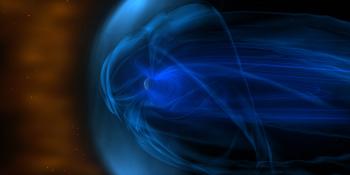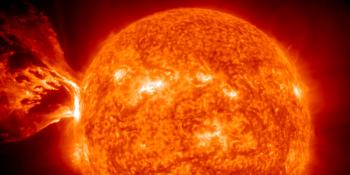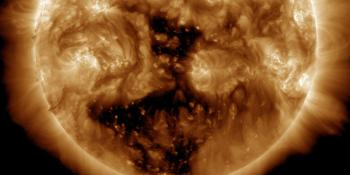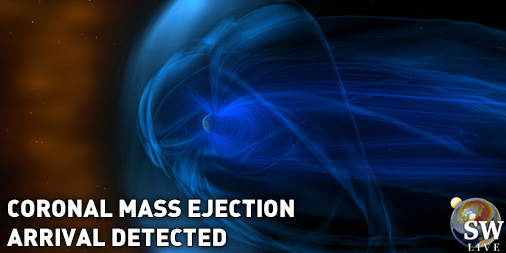Viewing archive of Wednesday, 26 September 2001
Solar activity report
Any mentioned solar flare in this report has a scaling factor applied by the Space Weather Prediction Center (SWPC). Because of the SWPC scaling factor, solar flares are reported as 42% smaller than for the science quality data. The scaling factor has been removed from our archived solar flare data to reflect the true physical units.
Report of Solar-Geophysical Activity 2001 Sep 26 2200 UTCPrepared by the NOAA © SWPC and processed by SpaceWeatherLive.com
Joint USAF/NOAA Report of Solar and Geophysical Activity
SDF Number 269 Issued at 2200Z on 26 Sep 2001IA. Analysis of Solar Active Regions and Activity from 25-2100Z to 26-2100Z
Solar activity has been moderate. Region 9628 (S18W26)
produced today's only M-class event, an M1 at 0258 UTC. The region
has shown a slight decline and simplification relative to yesterday,
but continues to be the largest on the disk and continues to have
strong, complex magnetic fields. Region 9632 (S19W08) also continues
to be impressive but produced only low-level C-class events. Region
9636 (N13E40) appears to be growing slowly and managed to produce a
couple subflares. New Region 9639 (N04E36) was assigned today and is
a simple beta-type sunspot group.
IB. Solar Activity Forecast
Solar activity is expected to be
moderate. There is a fair chance, however, for an isolated major
flare event or proton producing event from either of Regions 9632 or
9628.
IIA. Geophysical Activity Summary 25-2100Z to 26-2100Z
The geomagnetic field has ranged from quiet to major storm levels
during the past 24 hours. Following yesterday's sudden storm
commencement at 2025 UTC, the geomagnetic field became disturbed,
and attained major storm levels between 2100-2400 UTC. Conditions
declined slightly from 0000-1200 UTC, with active to minor storm
levels predominating. Activity was quiet to unsettled for the
remainder of the period. The greater than 10 MeV proton event
continues in progress. A maximum flux of 12900 pfu was observed at
25/2235 UTC, after which the flux levels have been steadily
declining. The greater than 100 MeV proton event that began at
1440 UTC on the 24th attained maximum of 31 PFU at 25/0755 UTC and
ended at 26/1940 UTC.
IIB. Geophysical Activity Forecast
The geomagnetic field is
expected to be mostly unsettled during the next three days. There is
a chance for some active periods during the next 12 hours due to
persistence. Unsettled levels should dominate on the second day.
There is a chance for some active periods on the third day due to
the favorable position of a solar coronal hole. The greater than 10
MeV proton event is expected to continue for the next 42-48 hours.
III. Event Probabilities 27 Sep to 29 Sep
| Class M | 80% | 80% | 80% |
| Class X | 30% | 30% | 30% |
| Proton | 99% | 90% | 50% |
| PCAF | in progress | ||
IV. Penticton 10.7 cm Flux
Observed 26 Sep 283 Predicted 27 Sep-29 Sep 280/275/275 90 Day Mean 26 Sep 171
V. Geomagnetic A Indices
Observed Afr/Ap 25 Sep 017/018 Estimated Afr/Ap 26 Sep 022/025 Predicted Afr/Ap 27 Sep-29 Sep 015/010-010/010-015/015
VI. Geomagnetic Activity Probabilities 27 Sep to 29 Sep
| A. Middle Latitudes | |||
|---|---|---|---|
| Active | 35% | 30% | 35% |
| Minor storm | 20% | 15% | 25% |
| Major-severe storm | 10% | 05% | 10% |
| B. High Latitudes | |||
|---|---|---|---|
| Active | 30% | 30% | 30% |
| Minor storm | 20% | 15% | 30% |
| Major-severe storm | 15% | 05% | 20% |
All times in UTC
Currently there's no noteworthy space weather
Latest news
Latest forum messages
Ask your obscure/"stupid" space weather questions. 381Space Weather Memes 703Filaments and prominences 115AR 4055 121Growth of Cycle 25 834
More topicsSupport SpaceWeatherLive.com!
A lot of people come to SpaceWeatherLive to follow the Sun's activity or if there is aurora to be seen, but with more traffic comes higher server costs. Consider a donation if you enjoy SpaceWeatherLive so we can keep the website online!

Latest alerts
Thursday, 24 April 2025
07:27 UTC - Hemispheric Power Index
The OVATION model predicts the Hemispheric Power Index to reach 50GW at 08:15 UTC
07:15 UTC - Geomagnetic activity
Active geomagnetic conditions (Kp4) Threshold Reached: 07:03 UTC
06:27 UTC - Coronal mass ejection arrival
CME impact detected - Current Solar Wind Speed 644km/sec - IMF: Bt (strength): 15nT & Bz: 0nT (South).
Space weather facts
| Last X-flare | 2025/03/28 | X1.1 |
| Last M-flare | 2025/04/22 | M1.3 |
| Last geomagnetic storm | 2025/04/21 | Kp5+ (G1) |
| Spotless days | |
|---|---|
| Last spotless day | 2022/06/08 |
| Monthly mean Sunspot Number | |
|---|---|
| March 2025 | 134.2 -20.4 |
| April 2025 | 122.8 -11.4 |
| Last 30 days | 117.7 -15.6 |




